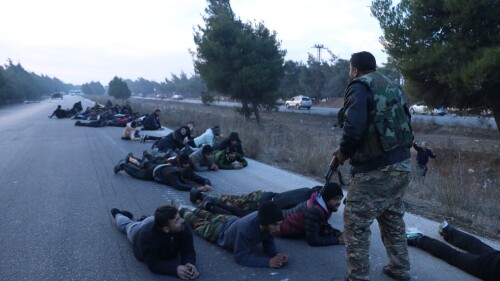Iranian proxies such as (clockwise from top left) Hezbollah in Lebanon, Kata’ib Hezbollah in Iraq, Ansar Allah in Yemen, and the Ja’afari Force in Syria are praying for a relaxation of U.S. pressure. |
I met Abu Mahdi al-Muhandis outside the oil town of Baiji, in Sunni northern Iraq, five years before he was killed by an American drone. The war against ISIS was at its height, and the Iranian military mastermind Qasem Soleimani — who met his end alongside Muhandis in January 2020 — had taken command of Iraqi Shia militias.
There were already rumours about their murderous behaviour toward Sunni civilians. That day, Muhandis was in good humour, calm and amused by the western journalists seeking an audience, and the high-ranking Iraqi Army officers who hung on his every word.
Now both Abu Mahdi al-Muhandis and Major General Qassem Soleimani lie in their graves. The militia strength which they built together, however, remains very much alive. It is part of an archipelago of client political-military organisations which Iran seeded across the Middle East, from the Gulf of Aden to the Mediterranean Coast. The creation of this network was Soleimani’s life’s work. Al-Muhandis was his friend, protégé, and key lieutenant in Iraq.
The demise of the two men, combined with intense US sanctions, has brought the Iranian militia structure in the Middle East to its knees. But whether the incoming US administration will maintain that pressure is an open question — one that keeps leaders up at night across the region.
Iran’s proxy network was one of the main beneficiaries of the collapse of governance across the region that began with the Arab Spring. In Yemen, Iraq, Syria and Lebanon, the crumbling of the state allowed Soleimani to plant his client groups, building covert Iranian strength.
Tehran seeks to transform regional states into weakened host bodies where militias act with impunity.
In all of these countries, the goal was the same. Tehran did not seek to capture official state power. Rather, it wanted to transform the state into a weakened host body, allowing its parasitic militia to act with impunity. The long list of its armed groups shows the scale of the threat: the Ansar Allah movement in Yemen, Kata’ib Hezbollah — Muhandis’ organisation — in Iraq, the Lebanese Hezbollah, the Afghan Fatemiyoun group and the Pakistani Liwa Zainebiyoun — not to mention the myriad of militia in Syria.
Over the last two years, however, their advance has been halted, if not reversed. Largely, this has been achieved by the US, and is one of Donald Trump’s most notable foreign policy legacies.
Over the last two years, the advance of Iranian regional proxies has been halted.
The deaths of Soleimani and Muhandis left the militia structure decapitated. Assassination is an uncertain weapon, sometimes resulting in the emergence of a leader more formidable than the one removed. This has not been the case. Esmail Ghaani, who replaced Soleimani at the head of the Qods Force, and Abu Fadak al-Mohammadawi, now heading the pro-Iran militia structure in Iraq, are proving far less capable than the men who preceded them. The militia structure worked primarily on informal relationships, created by Soleimani over a period of years. These cannot simply be handed over to a replacement.
Alongside the drone strike that killed Soleimani and Muhandis came the US policy of “maximum pressure”. The sanctions imposed on the Iranian oil, financial and banking sectors in 2018 starved the economy of funds. This meant the closing of the tap for the militias. Hezbollah in Lebanon, for example, suffered a 40 per cent reduction funding in 2020. Similarly, the four top pro-Iran militias in Iraq saw their income fall from £3-4m per month to £1-2m.
The absent leadership and lack of money is having a dramatic affect. In Syria, where there is no large Shia population, Iran has had to use cash to entice recruits. This is no longer available. In Iraq, discipline and unity have begun to break down. In their own right, the powerful militias control oil fields, checkpoints, property and land. They are not prepared to mutely follow orders from fresh commanders for whom they have little respect.
There is now a real possibility that the winds are about to change once again in Iran’s favour. President-elect Joe Biden has made clear his desire to re-negotiate the 2015 nuclear accords with Iran. As a prerequisite, the theocracy is insisting on the lifting of all sanctions. In an attempt to focus American minds, it has threatened to expel international nuclear inspectors from the country on 21 February unless the money starts to flow again.
Lifting U.S. sanctions would revitalise Iran’s cashflow to the militias.
An early capitulation by the Biden administration would give away any leverage that the US currently holds, reducing any chances of achieving the improved deal the president-elect has said that he wants. Lifting sanctions would revitalise the cashflow to the militias, threatening to revive their forward motion. Abu Mahdi Al-Muhandis and Major General Qasem Soleimani are gone. Muhandis will stay in Najaf, where they buried him, until further notice and Soleimani will not be leaving the Kerman Martyrs Cemetery in southeast Iran any time soon. The structures these men created, however have not been wrecked but are only low on fuel.
It is up to Mr Biden whether they stay that way.
Jonathan Spyer is a Ginsburg/Milstein Writing Fellow at the Middle East Forum and director of the Middle East Center for Reporting and Analysis.








